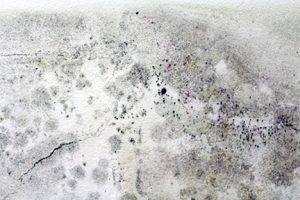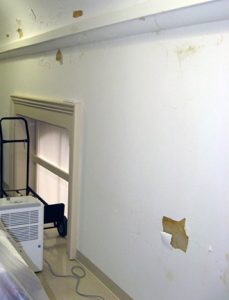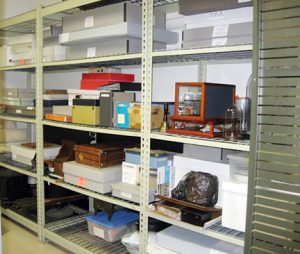Loretto Heritage Center Learns a Stunning Lesson About Mold
Posted on April 1, 2016, by Eleanor Craig SL
“To find mold in an archives building is like facing a tsunami, a hurricane and an earthquake all rolled into one disaster. When Archivist Eleanor Craig was summoned to the scene, she had to take to her chair in a state of temporary paralysis of fear.” — Our Days, January 2016

Photo courtesy of Eleanor Craig
It was exactly as Anndavid Naeger wrote in the Motherhouse newsletter: As Loretto’s archivist, charged with protecting our precious 200 years of papers and artifacts, I was overwhelmed when one of the housekeeping staff called me to see the 3-by-4-foot swath of black mold clinging to the surface of the outer wall of a storage hallway.
I knew just enough to go online to the Northeast Document Conservation Center and to the website of the National Archives to get help. Don’t use any strong chemicals, just lightly wash with detergent. We did that, then for two weeks I was paralyzed with fear in the face of this most dreaded, most warned-against enemy of archival practice.
Continuing to read, I learned that mold is in the air all around us, everywhere! It is generally inactive, but with high temperature, high humidity, water or dampness and a food source, mold will rapidly grow (within 24 hours!). Our mold found everything it needed in our second-floor west storage area, where warm afternoon sunlight and poor circulation combined with damp walls to provide ripe conditions. The food source? The mold was eating the very walls themselves, which was better than eating our artifacts or papers! Large colonies of mold were eating the paint on the surface of the outside wall. And not just in the upstairs storage area, but also on an outside wall in the museum.

Photo courtesy of Eleanor Craig
I notified Pearl McGivney and Vicki Schwartz. Their immediate concern: Was the mold a threat to the archives staff or visitors? While we found out, a process that took about a month, we posted a CLOSED sign on the museum and did our work in other places.
With all the emphasis on temperature and humidity, I turned down the thermostats in our already-chilly rooms and set up two large dehumidifiers. I also called our HVAC company and had all the parts of our air circulation system checked for active mold. There was no mold in the ducts, praise God!
Our insurance company sent an adjuster, who spent Labor Day with me in the Heritage Center climbing in the attic and on the roof looking for what could be causing the walls to be so wet. Willing as he was, he could not find the cause. Two commercial cleanup companies looked at our problem; neither had a satisfactory explanation for the wet walls nor an adequate plan to fix them.

Photo courtesy of Eleanor Craig
Finally, colleagues at the Kentucky Historical Society recommended an historic renovations company in Louisville. John Schnurr came to visit, looked at the wet walls and said we would have to find what was making them wet before any remediation process could succeed. He climbed up to the attic and concluded that our problems were possibly coming from our gutters — the original copper guttering, installed in 1886 when the building was constructed. Schnurr also examined photographs of the renovations in 2009, which suggested that downspouts had been removed, leaving high water volume in the gutters with nowhere to go.
I was so relieved to have thoughtful analysis from a professional who works on historic buildings. I arranged for Schnurr to organize and supervise the whole project of correcting our mold problem. During the next three months, Schnurr called in a roofing company, whose experts found the source of the water. It was a 5-by-3-inch gap left in the gutter when new roofing was laid 15 years ago. The gap allowed water to overflow directly onto the 2-foot brick walls, saturating them until the dampness came through to the inside. Once the source of water was discovered and fixed, we waited through three autumn storms to see if the fix would hold. It did, and it has continued to hold.
Next Schnurr called in mold remediation experts who isolated the mold areas in our upstairs storage and in the museum itself. Each area was contained completely in plastic tents. Workers then tore off the two-inch thick, 130-year-old plaster which the mold was eating, leaving the outside brick walls exposed. They set up industrial-sized dehumidifiers and air cleaners and left them running for two months until the brick walls were completely dry. Finally, Schnurr’s own specialists plastered, restoring the inside of the brick walls to their old selves.

Photo courtesy of Eleanor Craig
All together the process from discovery to recovery took seven months. There were several silver linings. First, we gained a lot of confidence in our ability to overcome paralysis and respond to even severe threats. Second, having to clear out a large storage area, we were motivated to find permanent alternative storage solutions. Just when we needed it, free shelving was offered us by the Carmelite Monastery which was closing in Louisville, a gift valued at well over $7,000. Third, before putting things back, we took the time to organize what had been a haphazard collection. Today our artifacts and print materials are housed in clean, spacious areas on beautifully organized shelving with accurate labels and computer listings to help us find each little thing.
With the mold crisis finally behind us, the Heritage Center staff are returning to several big projects. First, we are transforming our methods of finding items and information. In the past, staff and visiting researchers had to “let your fingers do the walking” through pages and pages of typed information to find items. Soon researchers can conduct a Google-like search of computer listings. During the next several years we will steadily expand the amount of our archived materials that are computer described and searchable. Related to our digital description project is our plan to design and conduct archival internships for graduate students from nearby university programs in public history and library science. The interns will work with us for 200-300 hours — a semester or a summer — adding to our computer search capabilities while acquiring experience and archival training. Teaching interns will connect our archives to the wider world of public archives and universities.

Photo courtesy of Eleanor Craig
Finally, this spring we will add a fully trained professional archivist to the staff of the Heritage Center. During the next several years, we will gradually transfer management of our collections of documents, photographs and artifacts to a person with the professional preparation and work experience to take charge of the Heritage Center —just in time for me to retire!
